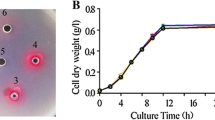Abstract
In Pseudomonas aeruginosa, quorum sensing (QS) regulates dozens of genes and proteins, many of which contribute to the virulence of this pathogen. QS inhibitory (QSI) compounds have been proposed as potential agents for treatment of bacterial infections. To search for Ps. aeruginosa QS inhibitors, we constructed an effective screening system, QSIS-lasI selector, based on the PlasI-sacB reporter, in which QS could be induced with 20 nM 3-oxo-N-[(3S)-tetrahydro-2-oxo-3-furanyl]-dodecanamide (3-oxo-C12-HSL). During screening of the crude extracts from 65 marine fungi, an isolate of Penicillium atramentosum was found to have QSI activity. Thin-layer chromatography assay of the fungal extracts for bioautographic identification of QSIS-lasI indicated that this fungus produced several QSI compounds, including QS inhibitors other than penicillic acid or patulin.




Similar content being viewed by others
References
Alagely A, Rajamani S, Teplitski M (2011) Luminescent reporters and their applications for the characterization of signals and signal-mimics that alter LasR-mediated quorum sensing. Methods Mol Biol 692:113–130
Alastruey-Izquierdo A, Cuenca-Estrella M, Monzon A et al (2007) Prevalence and susceptibility testing of new species of Pseudallescheria and Scedosporium in a collection of clinical mold isolates. Antimicrob Agents Chemother 51:748–751
de Kievit TR, Kakai Y, Register JK et al (2002) Role of the Pseudomonas aeruginosa las and rhl quorum-sensing systems in rhlI regulation. FEMS Microbiol Lett 212:101–106
Dekimpe V, Deziel E (2009) Revisiting the quorum-sensing hierarchy in Pseudomonas aeruginosa: the transcriptional regulator RhlR regulates LasR-specific factors. Microbiology 155:712–723
Givskov M, de Nys R, Manefield M et al (1996) Eukaryotic interference with homoserine lactone-mediated prokaryotic signalling. J Bacteriol 178:6618–6622
Hentzer M, Wu H, Andersen JB et al (2003) Attenuation of Pseudomonas aeruginosa virulence by quorum sensing inhibitors. EMBO J 22:3803–3815
McGrath S, Wade DS, Pesci EC (2004) Dueling quorum sensing systems in Pseudomonas aeruginosa control the production of the Pseudomonas quinolone signal (PQS). FEMS Microbiol Lett 230:27–34
Pearson J, Pesci E, Iglewski B (1997) Roles of Pseudomonas aeruginosa las and rhl quorum-sensing systems in control of elastase and rhamnolipid biosynthesis genes. J Bacteriol 179:5756–5767
Rasmussen T, Bjarnsholt T, Skindersoe M et al (2005a) Screening for quorum-sensing inhibitors (QSI) by use of a novel genetic system, the QSI selector. J Bacteriol 187:1799–1814
Rasmussen TB, Skindersoe ME, Bjarnsholt T et al (2005b) Identity and effects of quorum-sensing inhibitors produced by Penicillium species. Microbiology 151:1325–1340
Schuster M, Greenberg E (2007) Early activation of quorum sensing in Pseudomonas aeruginosa reveals the architecture of a complex regulon. BMC Genomics 8:287
Skindersoe ME, Ettinger-Epstein P, Rasmussen TB et al (2008) Quorum sensing antagonism from marine organisms. Mar Biotechnol (NY) 10:56–63
Wang J, Lory S, Ramphal R et al (1996) Isolation and characterization of Pseudomonas aeruginosa genes inducible by respiratory mucus derived from cystic fibrosis patients. Mol Microbiol 22:1005–1012
Acknowledgments
This research was supported by the National Program of High-tech Research & Development of China (NO. 2007AA09Z418) and Open Research Fund Program of Key Laboratory of Marine Drugs (Ocean University of China, KLMD (OUC) 200806). We would like to thank Dr. Michael Givskov for providing us with the QSIS2 strain. We also thank Dr. E Peter Greenberg for providing us with the PAO1 and PAO MWI strains.
Author information
Authors and Affiliations
Corresponding author
Electronic supplementary material
Below is the link to the electronic supplementary material.
Rights and permissions
About this article
Cite this article
Wang, L., Zou, S., Yin, S. et al. Construction of an effective screening system for detection of Pseudomonas aeruginosa quorum sensing inhibitors and its application in bioautographic thin-layer chromatography. Biotechnol Lett 33, 1381–1387 (2011). https://doi.org/10.1007/s10529-011-0563-2
Received:
Accepted:
Published:
Issue Date:
DOI: https://doi.org/10.1007/s10529-011-0563-2



